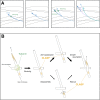Microtubule reorientation in the blue spotlight: Cutting and CLASPing at dynamic hot spots
- PMID: 30573524
- PMCID: PMC6314537
- DOI: 10.1083/jcb.201812063
Microtubule reorientation in the blue spotlight: Cutting and CLASPing at dynamic hot spots
Erratum in
-
Correction: Microtubule reorientation in the blue spotlight: Cutting and CLASPing at dynamic hot spots.J Cell Biol. 2019 Feb 4;218(2):723. doi: 10.1083/jcb.20181206301102019c. Epub 2019 Jan 11. J Cell Biol. 2019. PMID: 30635351 Free PMC article. No abstract available.
Abstract
Microtubule reorientation into a longitudinal network during the phototropic response in Arabidopsis thaliana depends on their severing by katanin at crossovers. Lindeboom et al. (2019. J. Cell Biol. https://doi.org/10.1083/jcb.201805047) show that at newly generated plus ends, the anti-catastrophe activity of CLASP is essential for further growth.
© 2018 Benoit and Poüs.
Figures

Comment on
-
CLASP stabilization of plus ends created by severing promotes microtubule creation and reorientation.J Cell Biol. 2019 Jan 7;218(1):190-205. doi: 10.1083/jcb.201805047. Epub 2018 Oct 30. J Cell Biol. 2019. PMID: 30377221 Free PMC article.
References
Publication types
MeSH terms
Substances
LinkOut - more resources
Full Text Sources

